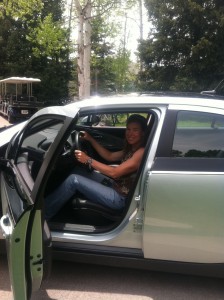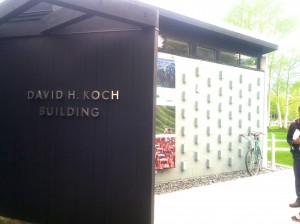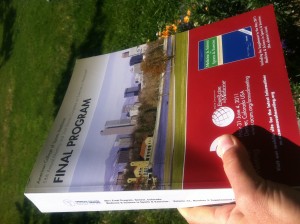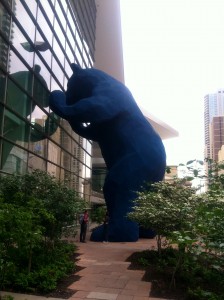I’m not a big fan of conferences. I loathe spending vast stretches of time indoors, especially if it requires planting my butt in uncomfortable chairs and wearing clothes with buttons and shoes that aren’t flip flops. Yet I continue to attend meetings, because they offer opportunities to interact with smart people who are thinking about interesting things.
Earlier this month, I attended two conferences in a single week, and the stark contrast between them got me thinking about why conferences so often suck and how to make them better.

The first stop on my summer conference tour was the Aspen Environment Forum (AEF). I’ve never attended a conference at the Aspen Institute that I didn’t love. It’s a beautiful campus, just a short drive from my house, and they always serve good food. I’ve attended the AEF three years in a row now and each time I’ve come away feeling invigorated and intellectually enriched. I’ve also made connections with sources that have enhanced my work.
From Aspen, I drove east to the annual meeting of the American College of Sports Medicine (ACSM), held at the Colorado Convention Center in downtown Denver. This was my second time attending the ACSM meeting (the first was also in Denver, in 2006). Both times I left with a pocket full of business cards, a notebook packed with story ideas and a brain completely fried.
In all fairness, these two conferences had completely different missions and purposes. Both of them did some things well and others not so much, but the differences between them highlight the factors that make a meeting energizing or mind-numbing.
What makes the Aspen Environment Forum so good?
One of the things the AEF has going for it is its small size, just 300 or so people. At about twice Dunbar’s number, this is more attendees than any one person can reasonably interact with in a meaningful way, and yet sessions are small enough to promote connections.

Sessions take place mostly in small conference rooms, many of which are arranged so that everyone sits in a circular formation facing one another. Each panel features multiple speakers, and they engage in a moderated conversation together, rather than taking turns as talking heads. Moderators at AEF leave ample time for questions, and panelists engage, rather than pontificate. Occasionally, sessions include slideshows or visuals, but for the most part, the AEF is a PowerPoint-free zone. This format promotes a two-way exchange of ideas, rather than the one-way, single speaker brain dump so common at other conferences.
The Aspen Institute itself provides another piece of the AEF’s success formula. Most conference rooms have natural light in them, which prevents them from feeling like dungeons. Sessions are held in various buildings spread out across a lush, green campus. Between talks, attendees must walk from building to building along scenic walking paths. These short walks give people a chance to bump into one another and interact in a natural way.
I’ve never seen a study to confirm it, but I know from personal experience that a brisk walk can reboot the brain and facilitate the flow of ideas. An agenda that forces people to get up and walk outside a little bit every few hours seems a potent antidote to what I’ll call “conference brain,” that mind numbness that sets in after an hour of PowerPoint slides.
What makes the ACSM so overwhelming?

First, it’s huge. The final program looks like a phone book from a major metropolis and would probably take several days of nonstop reading to get through. (Which is why the meeting planner is so awesome.) More than 6,000 people attend the ACSM meeting. It’s a U2 stadium concert to the AEF’s house party. You’re there to hear the music, but you don’t expect to have much dinner party conversation.
Unlike the AEF, which features speakers in conversation, the ACSM talks generally follow a format where one scientist stands up and lectures for 30 minutes, then yields the podium to another lecturer and then another and then finally after three or four of these talks, the floor is opened to questions from the audience. It goes without saying that nearly every one of these speakers uses a PowerPoint presentation, many of which are illegible.
This isn’t to say that the talks I attended at ACSM were boring. They were almost universally fascinating, but the environment in which they took place— large, dark rooms in a cavernous conference hall with very little natural light — provoked an almost insurmountable urge to nod off.
Lessons Learned

So what could these meetings learn from each other, and how could conferences in general be improved? The AEF and ACSM meetings had distinctly different purposes, and there’s simply no way a meeting as big as ACSM could adopt the same format as AEF.
To their credit, the ACSM folks did a lot of things right, like provide attendees a chance for exercise (at 6am on a Saturday morning), and they organized sessions in topic areas that presumably brought attendees with similar interests together in one room.
But I was disappointed by the lack of vigorous discussion and engagement at the ACSM sessions I attended. For me, the most useful conversations and insights at ACSM took place in hallways between sessions and in one-on-one discussions after talks had ended. Ross Tucker at the Science of Sport also wrote about his disappointment with the meeting (which we discussed privately, between sessions).
I’ve been to countless annual meetings of scientific organizations (FASEB, AAAS, AGU, to name just a few) and most are very similar to ACSM. I’ll keep returning, but I’d love to see these meetings adopt some of the AEF’s hallmarks, in particular, more interactive sessions and fewer PowerPoints. While I’m at it, can we agree to just kill PowerPoint? (Google “PowerPoint sucks” and you get 4,260,000 results, including comedian Don McMillan’s PowerPoint sketch, this and this.)
In this age of the internet, it’s easy to distribute data and slides. People go to meetings to get face time with colleagues, to build relationships with potential collaborators and to make connections they couldn’t make virtually. These are the kinds of interactions that meetings should emphasize.
How to do this? I like Seth Godin’s proposal, which he wrote about in a piece about intentionally building communities.
If the hallway conversations at a convention are worth more than the sessions, why not have more and better hallways?
I will discuss ways this might be done in a future post. In the meantime, if you have a suggestion or an experience to share, please do so in the comments here or email me: christie [at] nasw.org.

What a great topic. You’re right that naturally lit venues are key, and I would add that set-ups that are wide, rather than deep, work well.
The Geoscience Forum that’s held in my town places the talks in the movie theatre, which is one of the deepest and darkest possible choices — and this leads to exactly the conference brain you spoke of.
People who do it very well are the TED guys, who are constantly redesigning their social spaces for a lively discussion, though they’re dead set against panels or breakout groups.
I’ve never been to Aspen, but I can imagine the freshness of it, having experienced the Banff Centre for the Arts in all its mountainous glory.
Your thoughts are apropos for not just conferences, but any organization meetings. People belong to a club or organization for the personal interaction and often the meeting organizers have so much scheduled that there is no time or place for interaction. Is this why “social media” is so popular–people no longer have the opportunity to talk to each other face-to-face?
Didja see this?
http://sciencecareers.sciencemag.org/career_magazine/previous_issues/articles/2011_06_03/caredit.a1100049
Thanks for sharing that link Naomi. Prezi (http://prezi.com/), the program mentioned in that Science Careers piece, looks like a terrific alternative to PowerPoint.
Hallway chats are the best. I’ve often wondered how dependent they are on boring darkened room slide talks. You come out bleary-eyed, nearly desperate to make a real human connection. Plus complaining is a great conversation starter…
I don’t share your antipathy to Powerpoint (or other presentation software), as it seems to me rather that visuals help people concentrate and find interest in material that might not otherwise be as easily accessible, but, I certainly agree that the conversations at conferences are why people go and what people most enjoy. For exactly this reason I have seen somewhere a quasi-serious proposal for a conference without any papers, just with exhibits in session rooms that people could move between as they liked. I thought that this was at either of In the Middle of Middle Savagery, at both of which the various bloggers have been writing about messing with the traditional conference format, but I can’t now find it. Nonetheless, you’re not alone in this feeling.
Thanks for the thoughtful feedback Jonathan.
I think the proposal to eliminate papers at conferences is a good one. Stay tuned… I’ve been receiving a lot of feedback on this issue and plan another post once I’ve collated all the suggestions.